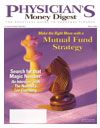Publication
Article
Physician's Money Digest
Involve Your Child in a Simple Savings Plan
Author(s):
Piggy banks are famous forstoring the wealth ofAmerica's youth. Usuallyfound on the nightstand ofthe typical 5-to 8-year-old,they contain tangible dollars and centsthat children can see and smell. Thepiggy bank is the key to understandingwhat your children value, helpingthem understand what they shouldvalue in the future, and teaching themthe importance of saving their cents.
Stock Market Game
For young children, a $1 bill thatsits in their nightstand stash may seemmore valuable than the $100 checkgrandma and grandpa gave them fortheir last birthday. Why? Their parentstook the liberty of purchasing a fewshares of stock with their birthdaymoney at the local brokerage firm. Tothe child, it might as well have fallendown a deep, dark hole. Althoughmost parents have good intentionswhen investing their child's gift, theyhave taken the control away fromtheir child and placed it into the handsof an institution too complicated forthe child to understand. Even afterparents take the time to explain thatmoney invested into the stock marketcan earn even more money, no choresattached, their youngster will still prefertheir piggy bank.
Before rushing to the broker, expandon your swift explanation ofsavings. Help your child understandthe world of money by accommodatingtheir reliance on tangible objects.Take them to the brokerage firm andshow them around. Introduce them tothe firm's employees, and let yourchild choose the company in whichthey would be proud to own a bit ofstock. Their favorite toy company orfast food restaurant chain would bea great choice. With a newfound familiarity,the stockbroker is no longer amoney-eating monster, but instead aperson who may enhance their treasures.One thing to remember is thatbrokerage accounts may not be openedin a child's name, aside from a custodialtype of account, until the age ofmajority. But you can still introducethem to the concept.
Monetary Lessons
After helping your child buy a fewshares of stock, show them how to followtheir stock on the Internet. By givingthem a visual representation of thevalue of their stock on a daily basis, itallows them to become involved withtheir investment, giving them the controlto check on it whenever theywant. While this gives them ownershipand a tangible understanding of theirassets in the stock market, the idea ofinterest earned in savings accountsmay still be difficult to understand.Because it may be paid too infrequentlyfor a child to comprehend its value,it may be wise to add a bit of "interest" to their at-home stash. By understandingthat their piggy bank "earns" money on a regular basis, they maylearn that by saving more money, theycan earn more money.
Hopefully, as children begin theirreal-world introduction to these morecomplicated investment types, they arealso learning about the value of earningmoney. All this talk about savingsand accumulating interest is important,but it is meaningless until theyunderstand what their money is trulyworth. Let's go back to that $100 birthdaycheck. Obviously, the $100 that isgiven to them is worth a lot more oncethey realize how many weekends ofcutting grass are needed to earn theequivalent. By earning some moneythemselves, they may not want to wasteit on silly items right away. Instead,they may think twice and decide to fattentheir piggy bank.
is vice president, investments,
and a financial consultant with AG
Edwards in Hillsborough, NJ. He welcomes
questions or comments at 800-288-0901,
or visit www.agedwards.com. This article
was provided by AG Edwards & Sons, Inc, member SIPC.
Joseph F. Lagowski
